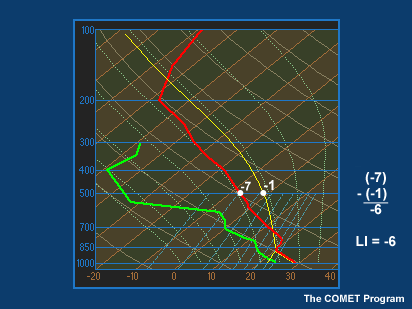Lifted Index

The lifted index (LI) is a simple parameter used to characterize the amount of instability in a given environment. It is calculated by lifting a representative parcel of air from the surface along the dry adiabat to its LCL, then along the moist adiabat to a level aloft, commonly 500 mb. Then we subtract the temperature of the lifted parcel from the observed temperature at that level.
When the lifted parcel is cooler than the environment at 500 mb, the LI is positive, we have negatively buoyant conditions, and the parcel will sink. Conversely, when the lifted parcel is warmer than the environment at 500mb, the LI is negative, we have positively buoyant conditions, and the parcel will continue to rise. LIs less than zero thus suggest the potential for convection, with LIs less than -4 increasing the potential for severe convection. LIs of -10 to -12 are not that uncommon in the spring and summer months over the central plains of the U.S.
The LI is an easy-to-calculate estimate of the convective potential. However, since it is calculated at only one level, there are many situations in which it may not properly represent the true convective potential. For this reason, LIs should not be used without also having reference to the full sounding.